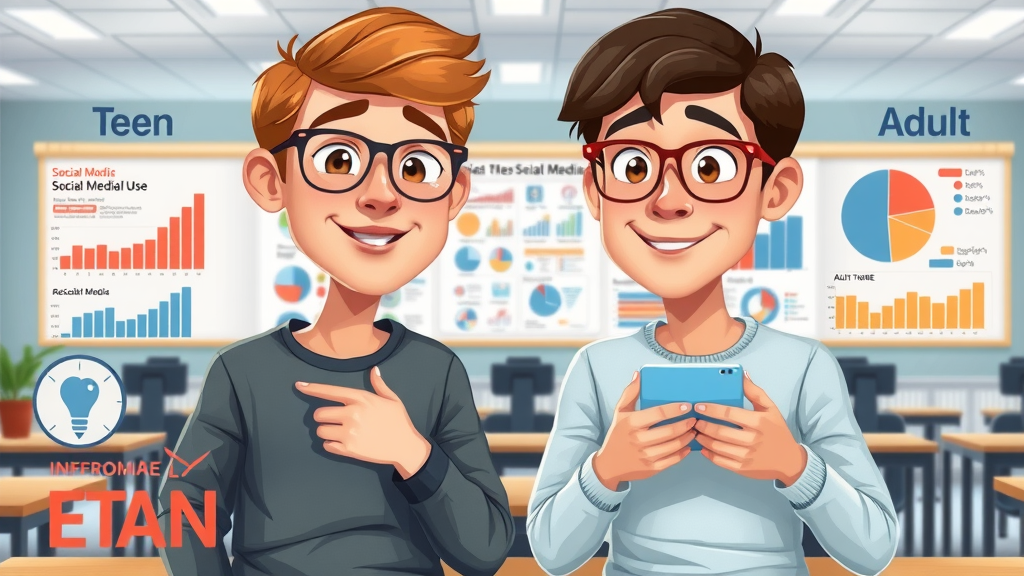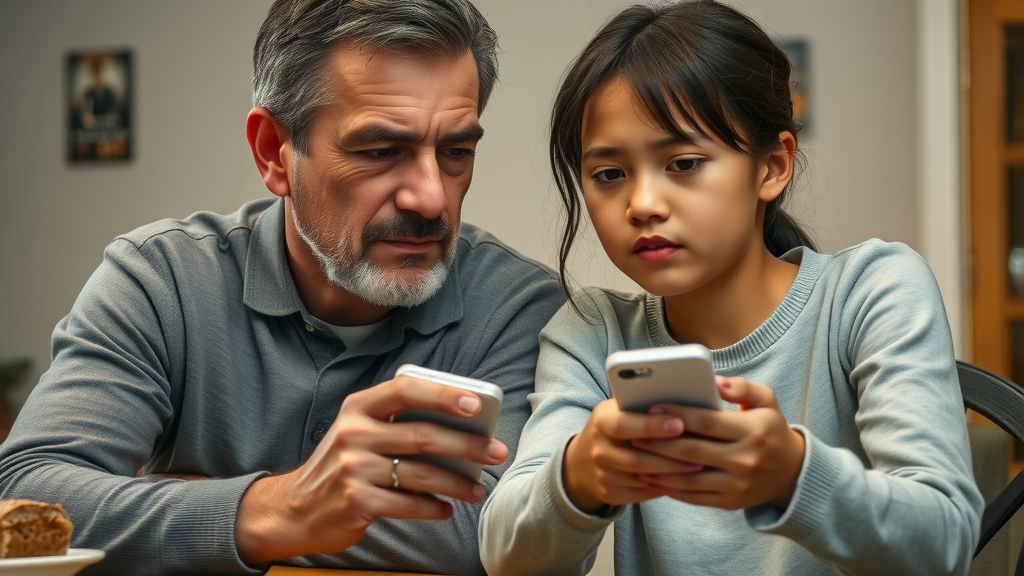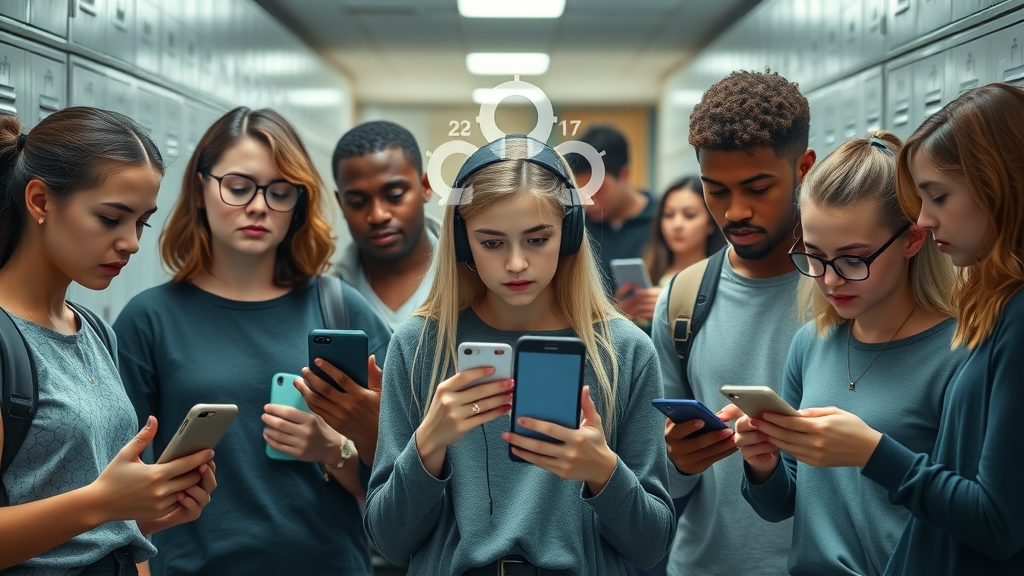Startling Statistic: Did you know that nearly 90% of teenagers aged 13-17 use social media daily? This unprecedented engagement brings connection and creativity, but also presents a growing threat: teen social media addiction is now recognized as a serious mental health issue, increasingly affecting families, schools, and entire communities. This article provides practical steps to recognize, understand, and combat this modern epidemic—arming you with the awareness and tools needed to protect the teens in your life.
An Alarming Reality: Unmasking Teen Social Media Addiction Today
"Recent studies show that nearly 90% of teenagers aged 13-17 use social media daily, making teen social media addiction a growing mental health concern in our society."
Teen social media addiction is no longer an isolated phenomenon; it’s an alarming reality impacting millions of families worldwide. With such a high percentage of teens consistently engaged on various social media platforms, the boundaries that separate healthy media usage from true media addiction often blur. Parents and caregivers are witnessing dramatic shifts in behavior, academic performance, and overall well-being, as teens become more invested in their online activities than ever before.
Beyond simply spending extra time on social media, many teens are exhibiting addicted to social media behaviors—like prioritizing online validation over real-life connections. This shift isn’t just a trend; it’s a public health issue with potential long-term consequences on teens’ mental health and emotional development. Recognizing these warning signs early is essential to prevent the detrimental effects of social media addiction in the next generation.

What You'll Learn About Teen Social Media Addiction
Key signs and symptoms of teen social media addiction
Insights into why teens become addicted to social media platforms
Actionable strategies for parents and caregivers to address media addiction
Long-term mental health effects of excessive media usage
Personal opinions and advice based on experience and research
Understanding Teen Social Media Addiction and Its Impact
Defining Teen Social Media Addiction: What Is a Social Media Addict?
Being a social media addict goes beyond loving to scroll through Instagram or send Snapchats. It refers to a set of compulsive behaviors where teens feel unable to control their media usage despite experiencing negative consequences. Teens addicted to social media often prioritize online interactions—even sacrificing sleep, school performance, and real-life relationships for digital validation.
This level of media addiction can lead to obsessive thoughts about content, stress over missing out on online events (FOMO), and even withdrawal symptoms when offline. Unlike moderate screen time, social media addiction involves a craving-like need for engagement, persistent preoccupation with one’s online status, and a decline in offline responsibilities. Understanding these compulsions is the first step to distinguishing between casual internet use and a serious behavioral health issue.
The Prevalence of Media Addiction Among Teens
The prevalence of media addiction among teens has soared in recent years, according to Pew Research and other studies. Today, teens spend an average of seven to nine hours a day on digital media platforms, a startling figure far surpassing adult averages. While most teenagers use social media for connection or entertainment, a growing percentage exhibit behaviors typical of a social media addict—including neglecting offline hobbies and becoming irritable without device access.
The ease of access to smartphones and tablets, combined with the addictive nature of modern media platforms, has increased both the intensity and duration of media usage among youths. This early and frequent exposure not only shapes their social and emotional development, but also introduces unique risks, such as increased anxiety, depression, and body image concerns—all linked to media addiction and problematic screen time.
Comparison of Social Media Usage Hours in Teens vs. Adults |
|
User Group |
Average Daily Social Media Usage (Hours) |
|---|---|
Teens (13–17) |
7–9 |
Adults (25–40) |
2–3 |

Mental Health Issues: The Connection Between Media Addiction and Teen Well-being
There’s a strong and growing body of evidence connecting media addiction to negative mental health outcomes in teens. Frequent and excessive use of social media platforms can trigger anxiety, depression, low self-esteem, and even contribute to the development of eating disorders. Teens compare themselves unfavorably to curated images online, fueling issues around body image and self-worth.
Moreover, the relentless cycle of notifications, messages, and online drama disrupts sleep and heightens emotional stress. This can lead to a number of health problems—from cognitive difficulties to increased rates of loneliness and social withdrawal. In extreme cases, untreated social media addiction can escalate to crisis points, underscoring why it is now recognized as a legitimate mental health issue that demands parental vigilance and community awareness.
Unveiling the Signs: Is Your Teen Addicted to Social Media?
Behavioral Changes and Red Flags of Teen Social Media Addiction
Spotting the difference between healthy digital habits and emerging addictive behaviors is crucial for early intervention. Be on the lookout for these behavioral changes, which often signal the development of media addiction:
Withdrawal from offline hobbies and once-loved activities
Irritability when unable to access devices or social networks
Preoccupation with online status and likes, often accompanied by anxiety
Declining school performance and missed deadlines
Social isolation from family and friends in favor of online communities
Many teens entangled in social media addiction will justify excessive media usage as necessary for “staying connected,” but parents must observe whether these justifications mask underlying distress or addictive behaviors. If your teen exhibits several of these red flags, it’s time to have a direct, compassionate conversation about their relationship with technology.
Physical and Emotional Symptoms of Media Addiction
The signs of teen social media addiction aren’t always limited to behavior. Emotional and physical symptoms also emerge as adolescents spend increasing time on social media. These might include difficulty concentrating, chronic fatigue, disrupted sleep patterns, and tension headaches. Teens might also seem increasingly anxious, moody, or emotionally exhausted—particularly when away from their preferred media platform.
More insidiously, excessive social media usage can trigger or worsen depression, and even create obsessive thought patterns about online activities and social validation. Teens with pre-existing mental health issues are especially vulnerable, and the fear of missing out (FOMO) or online drama can amplify these symptoms. Recognizing these warning signs is the first step in addressing the negative effects of social media addiction before lasting harm occurs.

Long-Term Effects of Social Media Addiction on Mental Health
Unchecked teen social media addiction can have severe long-term consequences on cognitive and emotional development. Research suggests repeated exposure to curated, unrealistic online personas can fundamentally distort self-image, leading to body image dissatisfaction, anxiety, and increased risk of eating disorders.
Additionally, persistent addictive behaviors escalate the risk of academic struggles, chronic stress, and strained real-world relationships. Many affected teens experience a decrease in academic performance, struggle with forming authentic friendships, and may develop dependency behaviors that persist into adulthood. In extreme cases, untreated media addiction contributes to deeper mental health issues, including addiction to other forms of technology or substances, underscoring the importance of early recognition and proactive intervention.
What Drives Teens to Become Social Media Addicts?
Psychological Triggers: FOMO, Validation, and Peer Pressure in Media Usage
Why are teens so susceptible to social media addiction? Much of it comes down to deep psychological forces—namely, the desire for acceptance, peer affirmation, and the ever-present fear of missing out (FOMO). Peer pressure is especially powerful: when a teen’s friend group is constantly active on a media platform, staying offline can mean exclusion from social circles or conversations.
Additionally, the instant feedback loop of likes, shares, and comments creates a powerful urge for social validation. Teens naturally want to fit in, and the digital culture of “likes = approval” fuels a cycle of addictive behavior. The design of media platforms amplifies this cycle by prioritizing engaging, addictive content; this is why media addicted teens often report anxiety and distress when unplugged, as they equate digital absence with social invisibility.

The Role of Social Media Algorithms in Maintaining Teen Media Addiction
Teens don’t become reliant on their devices by accident; behind every platform is a sophisticated algorithm designed to maximize time spent online. Social media algorithms learn user habits, promote highly engaging content, and send frequent notifications tailored to keep teens scrolling longer and returning more often. For an already vulnerable population, these tactics reinforce addictive behaviors.
The result? Teens are exposed to a near-constant stream of tailored information, memes, and peer updates, which can trigger dopamine surges in the brain—the same mechanism as in other forms of addiction. This cycle cements their dependency, making it challenging for media addicts to recognize when their media usage is becoming harmful. Being informed about the role algorithms play can empower parents and teens to recognize—and resist—the pull of addictive platform design.
Top Social Media Platforms Used by Teens and Average Daily Usage |
|
Social Media Platform |
Average Daily Use (Minutes) |
|---|---|
80 |
|
TikTok |
75 |
Snapchat |
60 |
30 |
|
25 |
Addressing Teen Social Media Addiction: Strategies That Work
Intervention: How to Recognize and Respond to a Teen Social Media Addict
Early intervention is vital when addressing teen social media addiction. Parents and caregivers must look beyond dismissals of “just texting friends” and instead observe underlying patterns: distress when offline, secrecy around media usage, or social withdrawal from family events. Trust and open communication are key; judgment or punishment often pushes teens further into hiding their behaviors.
Approach conversations from a place of curiosity and concern. Ask teens how social media makes them feel, and whether they’ve noticed any negative effects. Offer support, collaborate on healthier routines, and reinforce that your intention is to promote their overall mental health—not just to impose restrictions. For severe cases, do not hesitate to seek the guidance of school counselors, pediatricians, or trained mental health professionals.
Setting Boundaries for Healthy Social Media Usage
Creating tech-free zones at home
Scheduling digital detox times
Encouraging real-life social interactions
Open conversations about online experiences
Establishing clear, consistent boundaries is among the most effective ways to mitigate the risks of media addiction while supporting balanced growth. Parents can initiate tech-free zones—designating certain spaces, such as bedrooms or family rooms, as device-free areas. Compromise on screen time limits, setting mutual goals for device breaks or “digital detox” hours.
It’s equally important to reinforce positive offline habits by encouraging teens to participate in hobbies, sports, and face-to-face friendships. Share stories and concerns in regular family meetings, using open and supportive language so teens feel safe discussing their digital challenges. These strategies, backed by expert recommendations, are foundational to reclaiming healthy media usage in daily life.

Support Systems: Professional Help for Serious Cases of Media Addiction
Some cases of teen social media addiction may require a network of professional support. When addictive behaviors are deeply entrenched—manifesting as persistent anxiety, depression, or drastic drops in academic performance—turn to mental health professionals who specialize in adolescent behavioral issues. Therapists and counselors often utilize cognitive-behavioral therapy, group counseling, and digital detox programs tailored to a teen’s unique needs.
Remember, seeking outside help is a sign of parental strength, not failure. Consistent, empathetic intervention—bolstered by school personnel, community resources, and health care providers—gives struggling teens the chance to rebuild healthier relationships with technology. Patience, persistence, and professional collaboration are key elements to breaking the cycle of media addiction and reclaiming teens’ emotional well-being.
"Addressing teen social media addiction requires empathy, patience, and consistency from both parents and professionals."
Personal Reflections: My Perspective on Teen Social Media Addiction
Lessons Learned from Youth Affected by Social Media Addiction
As someone who has worked closely with teens impacted by media addiction, I’ve witnessed firsthand how quickly social media usage can spiral out of control. In my experience, the teens most at risk felt misunderstood or isolated long before their screen habits became problematic. For many, social media offered a temporary escape from real-world stress but ultimately fed their fears of exclusion and inadequacy.
It’s clear to me that the path to healing always begins with open dialogue—where teens feel heard rather than judged. By expressing genuine curiosity about their online lives, parents and mentors can break down barriers and guide teens to healthier habits. Every young person’s journey with social media is unique, but compassion and understanding never fail to build trust.
Why I Believe Social Media Addiction Is a Pressing Health Issue
In my opinion, teen social media addiction ranks among today’s most urgent public mental health issues. Unlike past generations, today’s teens are digitally “on” 24/7, with very little natural downtime to reflect, reset, or grow emotionally without external influence. This saturation of digital content not only disrupts healthy brain development but adversely affects every area of adolescent life—from body image and sleep to educational achievement and future relationships.
Both policy-makers and parents must recognize that media addiction isn’t just a “phase” or a personal failing—it’s a byproduct of a culture that prizes connectivity over balance. The urgency to address these underlying health problems is more critical than ever, as unchecked addiction will almost certainly lead to lifelong consequences for this generation and beyond.
Reframing Social Media Usage for a Healthier Teen Experience
Through my experience, I’ve found that total abstinence isn’t always necessary—nor is it realistic. Instead, empowering young people to set personal boundaries, reflect on their feelings, and prioritize in-person connections creates a solid foundation for healthier social media usage. I encourage parents and educators to focus on digital literacy, resilience, and self-esteem as tools for media wellness.
By reframing social media platforms as tools rather than necessities, we can help teens build a positive, confident digital identity while reducing the risk of media addiction. This shift enables teens to enjoy the benefits of technology without falling prey to its pitfalls—a balance we should all strive to support.

Real Stories: Teens Who Overcame Social Media Addiction
"I never realized how addicted to social media I'd become until I tried a week-long digital cleanse." – Anonymous Teen
The path from media addict to balanced digital user isn’t an easy one, but it’s absolutely possible. One student I worked with felt increasingly anxious, isolated, and unmotivated until her parents supported a gradual shift toward tech-free weekends, coupled with professional counseling. Through this intentional effort, she regained her confidence, rebuilt friendships, and ultimately reclaimed her joy in offline activities.
Other teens describe breakthroughs that come with small victories, such as switching off devices at night, replacing endless scrolling with creative hobbies, or consistently reaching out to real-life friends. Each success story is a testament to the resilience of young people—and a reminder that families, when equipped with knowledge and empathy, can help even the most connected teens overcome social media addiction.

Watch this informative video as experts, educators, and teens themselves unpack the realities of teen social media addiction, featuring compelling statistics and actionable tips for prevention and intervention.
People Also Ask: Teen Social Media Addiction FAQs
What are signs of social media addiction?
Common signs of teen social media addiction include frequent mood swings, anxiety or irritability without device access, a sharp decline in academic performance, and withdrawal from in-person friendships or family activities. Many teens also become secretive about their online activities and experience sleep disturbances due to late-night scrolling. The stronger the compulsive need to check devices, the more urgent a conversation about media addiction becomes.
Why are teens so addicted to social media?
Teens are especially vulnerable to social media addiction because of underlying psychological triggers like FOMO (Fear of Missing Out), a strong desire for peer validation, and exposure to constant social comparison. The design of social media platforms, with endless notifications and algorithmically tailored content, is engineered to capture attention and encourage addictive behaviors, deepening dependence over time.

How to break an addiction to social media?
Breaking free from teen social media addiction requires a combination of setting healthy boundaries, creating tech-free zones at home, scheduling regular device-free periods, and fostering open conversations about digital well-being. Encouraging participation in offline hobbies, building up self-confidence, and seeking professional help when necessary can all support long-term recovery and a healthier balance with technology.
How to tell if your child is addicted to social media?
Watch for notable changes like secrecy around media usage, withdrawal from once-loved activities, being constantly preoccupied with phones even at family events, and experiencing major mood swings tied to online life. A sudden drop in academic performance or inability to put devices away at night are also potential red flags. If you suspect social media addiction, start a non-judgmental dialogue about your teen’s experiences and feelings.
Answer: What are signs of social media addiction?
The most common signs include loss of interest in offline activities, irritability without devices, declining grades, obsessive concern with online status, secretive behavior, and evidence of social withdrawal. If such patterns persist, they may indicate a transition from heavy use to media addiction.
Answer: Why are teens so addicted to social media?
Teens are drawn to social media platforms out of a need for acceptance, connection, and instant feedback—which are amplified by platform algorithms aimed at maximizing engagement. Psychological factors like peer pressure and FOMO make it increasingly hard for teens to disconnect, fostering a cycle of addictive behavior and dependence.
Answer: How to break an addiction to social media?
To support a teen breaking a social media addiction, encourage clear device boundaries, offer alternative activities, and ensure regular offline time. Foster open discussion about both the positive and negative impacts of technology, and collaborate in finding healthier routines—reaching out for expert help if addiction remains persistent.
Answer: How to tell if your child is addicted to social media?
Frequent moodiness, decline in real-world interests, secrecy around digital activities, and an inability to manage screen time are major warning signs. If your child’s social media usage appears compulsive or causes distress when interrupted, it’s time for a supportive conversation and, potentially, guidance from a professional.
Frequently Asked Questions About Teen Social Media Addiction
Can social media addiction cause mental health issues in teens?
Are certain social media platforms more addictive than others?
What professional treatments are available for teen media addiction?
Key Takeaways: Combating Teen Social Media Addiction
Early recognition is crucial for addressing teen social media addiction.
Involvement from parents and professionals enhances recovery.
Cultivating healthy digital habits fosters long-term teen mental health.
Conclusion: The Road Ahead in Tackling Teen Social Media Addiction
Together, we can help teens build healthier, safer relationships with technology—starting with awareness, empathy, and open conversation.
"Protecting our teens from social media addiction today means empowering a healthier generation tomorrow."
Call to Action: Take a Stand Against Teen Social Media Addiction
Start a conversation with your teen about media usage today
Seek professional help if you notice warning signs
Advocate for responsible social media policies in your community
 Add Row
Add Row  Add
Add 





Write A Comment